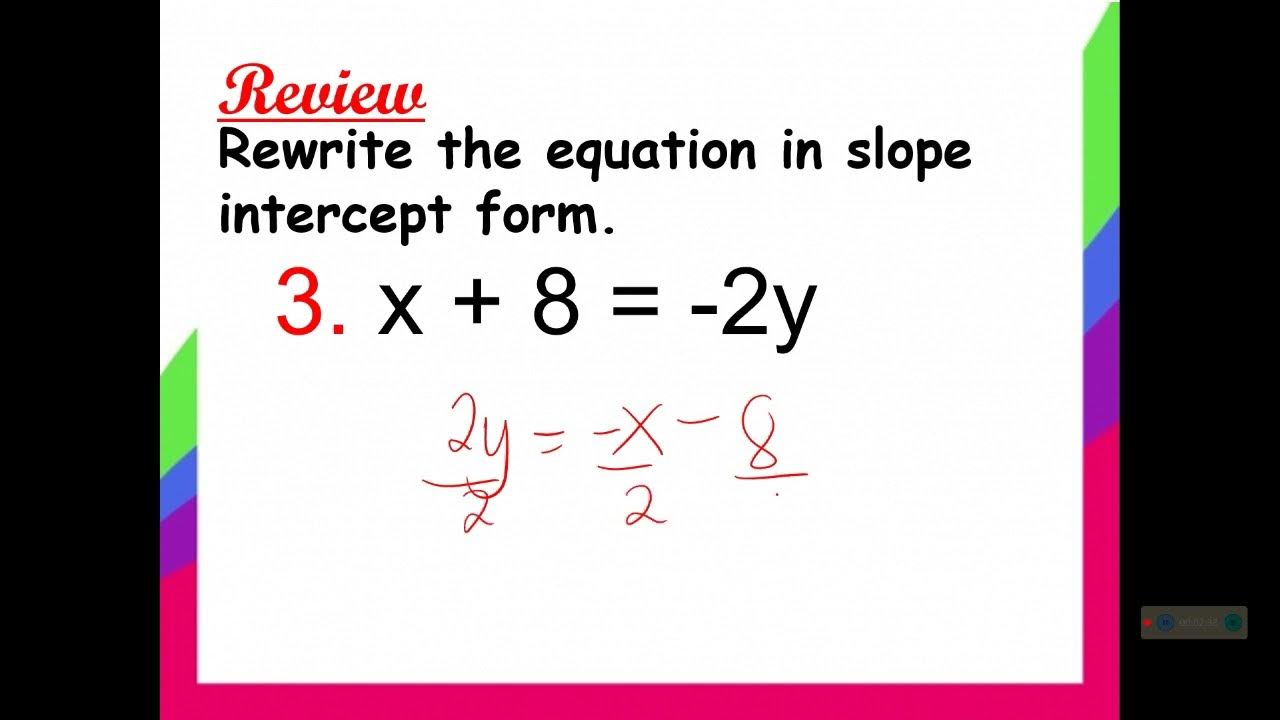Graph & illustrates Linear Function Find the Domain Range Table of values Intercepts & Slope Math 8
Summary
TLDRIn this lesson, Teacher Mel explains how to graph and analyze a linear function, focusing on its slope, intercepts, and table of values. Using the example function f(x) = -2x + 4, she demonstrates how to find the slope, x-intercept, and y-intercept. The lesson includes creating a table of values, graphing the function, and discussing its domain and range, which are both all real numbers. This video offers a comprehensive introduction to linear functions, ideal for students looking to master these key concepts in algebra.
Takeaways
- 😀 A linear function is expressed as f(x) = mx + b, where m is the slope and b is the y-intercept.
- 😀 The slope (m) represents the rate of change in a linear function and should not be equal to zero.
- 😀 The y-intercept (b) is the point where the graph of the function crosses the y-axis (x = 0).
- 😀 To find the x-intercept, set f(x) = 0 and solve for x.
- 😀 The degree of a linear function is always 1, meaning the graph is a straight line.
- 😀 The function f(x) = -2x + 4 has a slope of -2 and a y-intercept of 4.
- 😀 To find the x-intercept of f(x) = -2x + 4, set f(x) = 0 and solve for x, yielding x = 2.
- 😀 A table of values helps plot points to graph the function, providing specific values for given x-values.
- 😀 For the function f(x) = -2x + 4, when x = 0, y = 4; when x = 1, y = 2; and when x = 2, y = 0.
- 😀 The domain of a linear function is all real numbers, from negative infinity to positive infinity.
- 😀 The range of a linear function is also all real numbers, as the graph continues infinitely in both directions.
Q & A
What is a linear function?
-A linear function is a function of the form f(x) = mx + b, where m is the slope and b is the y-intercept. It represents a straight line when graphed, and the degree of the function is 1.
What do the variables m and b represent in the equation f(x) = mx + b?
-In the equation f(x) = mx + b, m represents the slope of the line, and b represents the y-intercept, which is the point where the line crosses the y-axis.
What does it mean if the slope m is not equal to zero?
-If the slope m is not equal to zero, the graph of the function will be a non-horizontal line. A slope of zero would result in a horizontal line, but here, the slope is -2, so the graph will be a declining line.
How do you find the slope of the line in the function f(x) = -2x + 4?
-In the function f(x) = -2x + 4, the slope is represented by m, which is -2. This means that for every 1 unit increase in x, the value of f(x) (or y) decreases by 2 units.
How do you find the y-intercept from the equation f(x) = -2x + 4?
-The y-intercept is the point where the line crosses the y-axis, which occurs when x = 0. Substituting x = 0 into the equation gives f(0) = 4, so the y-intercept is at (0, 4).
What is the process for finding the x-intercept?
-To find the x-intercept, set f(x) equal to 0 and solve for x. For the function f(x) = -2x + 4, setting 0 = -2x + 4 and solving gives x = 2. Therefore, the x-intercept is at (2, 0).
What does a table of values represent in graphing a linear function?
-A table of values shows the corresponding y-values for a given set of x-values. These points are plotted on the graph to visualize the linear relationship between x and y.
What points are used in the table of values for the function f(x) = -2x + 4?
-The points chosen for the table of values are x = 0, 1, 2, 3, and 4. For each x-value, the corresponding y-value is calculated using the equation f(x) = -2x + 4.
How do you graph the function f(x) = -2x + 4?
-To graph the function, plot the points from the table of values (e.g., (0, 4), (1, 2), (2, 0), etc.) and then connect them with a straight line. The graph will be a straight line that slopes downward due to the negative slope of -2.
What is the domain and range of the function f(x) = -2x + 4?
-The domain and range of a linear function are both all real numbers, as the graph extends infinitely in both directions along the x-axis and y-axis. Thus, the domain and range are both (-∞, ∞).
Outlines

This section is available to paid users only. Please upgrade to access this part.
Upgrade NowMindmap

This section is available to paid users only. Please upgrade to access this part.
Upgrade NowKeywords

This section is available to paid users only. Please upgrade to access this part.
Upgrade NowHighlights

This section is available to paid users only. Please upgrade to access this part.
Upgrade NowTranscripts

This section is available to paid users only. Please upgrade to access this part.
Upgrade NowBrowse More Related Video

Função do 1º Grau (Função Afim) | Matemática do Zero | Funções - Aula 01

Write and graph a linear function by examining a real-life scenario

How To Find The X and Y Intercepts of a Line

Taxa de Variação da Função Afim

ILLUSTRATING A LINEAR FUNCTION || GRADE 8 MATHEMATICS Q2

Graph of Linear Equations Using Slope Intercept (Part 1)
5.0 / 5 (0 votes)